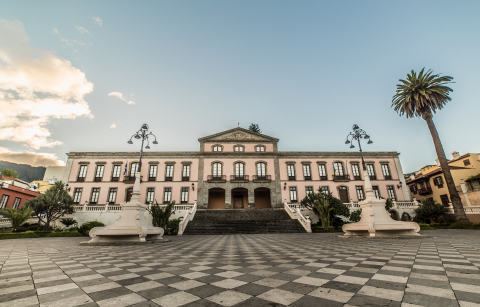
This area formed part of the San José nuns' convent, under the administration of the Franciscans, until well into the 19th century. The convent became municipal property and was eventually demolished after the 1836 Spanish confiscation decree. Numerous church properties became public property during this confiscation. Once the convent was demolished, this part of its site became the perfect site for celebrating traditional popular events. The current appearance of the square comes from the reform of the early 20th century. The checked floor is a Masonic reference to the principle of duality through the use of the opposite colours of black and white.
On the concrete benches, you can see what has been Orotava's official shield since 1905. The original shield was lost in the late 19th century after a fire destroyed the City Council building, without leaving any graphical record. The two dragons on the current shield represent the custodians of the mythical Hespérides garden, which in ancient times was believed to be in the Canaries, and also the two hillsides that border the valley to the east and west. In the centre you can see the huge dragon tree that existed in La Orotava in the Franchy and Alfaro family gardens until the 19th century, when it was blown down during a storm. The four golden apples depict the four villages that existed in the valley of La Orotava at the time the shield was created: La Orotava, Puerto de la Cruz, Realejo Alto and Realejo Bajo.
Since 1919, the square, which measures 900 square metres, has been used as a canvas over which the enormous sand carpet of Las Cañadas del Teide is made. In 2007, the carpet on this square was awarded the Guinness Record for the largest tapestry made with sand. Most of the sands come from Las Cañadas del Teide and their colours are natural, without any pigment. They’re a Christian tradition and are made during the Corpus Christi festivities, between May and June.
The carpets are one of the town's main hallmarks and have received national and international recognition thanks to the hundreds of thousands of visitors that flock to La Orotava each year. Later on this route, you’ll go past the Carpet Art Centre and have the chance to find out more about their history and production.
Look now towards one of the houses on the square's perimeter, with its curious wrought iron pergola on the top floor. This is the Bethencourt y Castro House. The young Bethencourt y Castro daughters, Maria Rosa, Josefa and Rosario lived there. They belonged to La Orotava's aristocracy at the end of the 19th century. They were very popular at the time due to their extravagant tastes, such as adorning themselves with flower garlands and travelling in a horse-drawn carriage at a time when there were cars on the road.
Let's go up to number 20 on the same street to listen to the next track.





